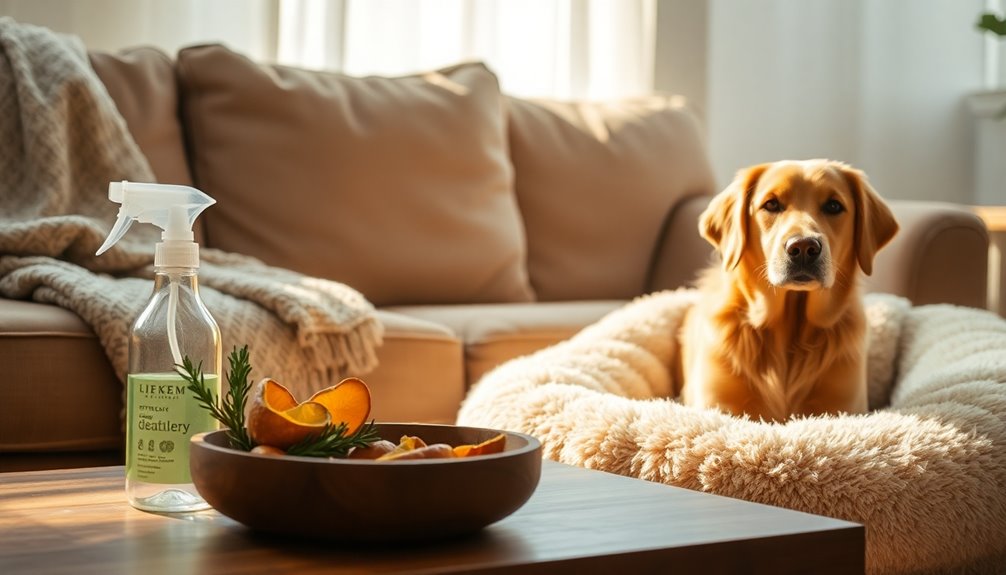To keep dogs off your furniture, start by using physical barriers like baby gates or upside-down chairs. Train your dog with a consistent “Off” command, rewarding them for obedience. You can use aluminum foil on furniture to create an uncomfortable texture. For a natural solution, mix one part vinegar with five parts water and spray it on your furniture. Consider creating a designated space with a comfy dog bed to redirect your dog’s attention. Consistency is key, so reinforce the rules firmly and patiently. There’s more effective strategies you can explore to ensure your home remains dog-free. Additionally, you may want to explore various training techniques that reinforce the idea of no pets on the furniture. Researching how to prevent pets on furniture can provide you with valuable insights and creative solutions tailored to your dog’s behavior. Remember, the goal is to create a comfortable environment for both you and your pet while maintaining the integrity of your furniture.
Key Takeaways
- Use a homemade vinegar solution (1 part vinegar to 5 parts water) to spray on furniture, deterring dogs with its strong scent.
- Implement consistent training by using the "Off" command and rewarding your dog for obeying.
- Create physical barriers, like baby gates or furniture obstacles, to restrict access to off-limit areas.
- Establish a comfortable, designated space for your dog with a cozy bed and toys to encourage them to stay there.
- Utilize aluminum foil on furniture surfaces to provide an uncomfortable texture that discourages dogs from jumping up.
Using Physical Barriers
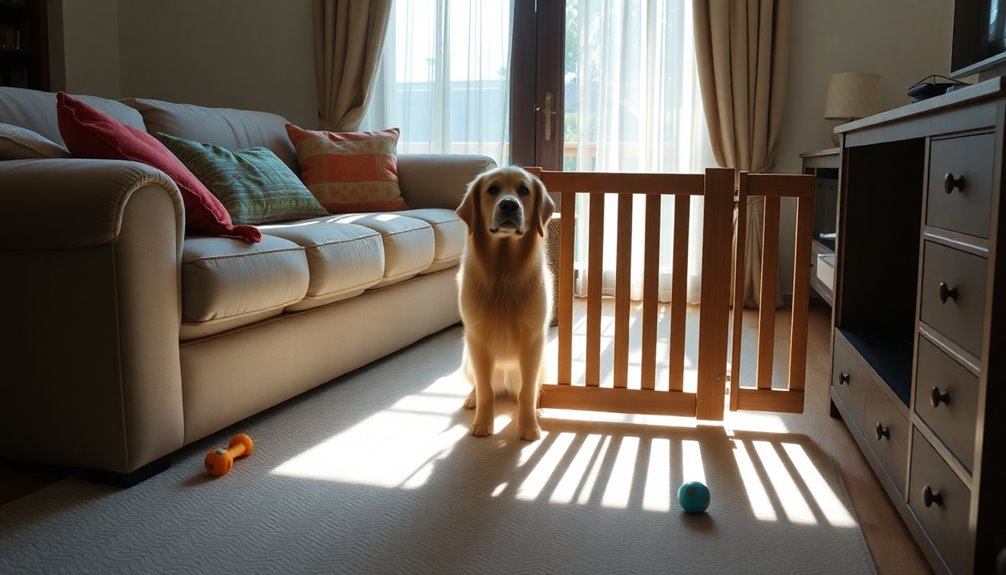
To keep your dog off the furniture, using physical barriers can be highly effective. Start by placing laundry baskets, upside-down chairs, or other obstacles on the furniture to deter your dog from climbing up. You can also remove the cushions from the sofa and stand them upright against a wall to make it less inviting. Consider using baby gates or pet barriers to block access to rooms where your furniture is located. Maintaining a clean home environment contributes to overall family health, so be sure to regularly clean any areas your dog frequents.
Specific products, like couch defenders, can create a physical barrier to prevent pets from jumping on the couch. Furniture pads that make crinkling sounds or X-Mat Pet Training Mats with pointy nubs can also be helpful. Additionally, you might try aluminum foil or plastic runners to make the furniture uncomfortable for your dog.
Managing your environment is crucial, too. Close doors to rooms with furniture and flip up the cushions or place boxes on the sofa when you leave. Consistency is key; make sure everyone in your household follows the same rules to prevent confusion for your dog. Over time, you can gradually remove barriers as your dog learns to stay off the furniture.
Training and Reinforcement Techniques

Training your dog to stay off the furniture involves consistent commands and positive reinforcement. Start by using the "Off" command whenever your dog attempts to jump onto the furniture. Lead your dog towards the furniture and say "Off" just before they leap up. When they obey, reward them with praise or treats. It's crucial that everyone in your household uses the same command to avoid confusion, so make sure all family members are aligned on the training approach.
To provide alternatives, set up comfortable dog beds near the furniture, placing treats or toys in them to make them appealing. Using a familiar scent, like an old shirt, can make the bed feel more inviting. Position the dog bed where your dog can still interact with the family. Consistency in training is vital for reinforcing the desired behavior and helping your dog understand the rules.
Positive reinforcement plays a key role, so reward your dog with praise, treats, or a favorite toy when they choose their bed over the furniture. Keep your energy calm to prevent excitement that might lead them back onto the furniture. By consistently reinforcing good behavior, you'll help your dog build a strong association with staying off the furniture.
Aluminum Foil Deterrent Method

Often, using aluminum foil can be an effective way to keep dogs off furniture. The uncomfortable texture and crinkly sound of the foil can deter your dog, making them think twice before jumping up. Simply place a long sheet of aluminum foil across the areas where your dog typically tries to climb. Cover the entire surface to prevent them from finding a non-foiled spot to land.
This method works particularly well for short-term deterrence, as most dogs dislike the unusual sensation of the foil. However, keep in mind that effectiveness can vary based on your dog's individual preferences. Some may eventually become accustomed to the foil and ignore it altogether. Dogs exhibit aversion to unusual surfaces and it's important to leave the foil in place for several weeks to help your dog associate the area with discomfort. But be cautious—while this method can temporarily manage the problem, it doesn't teach your dog what's acceptable or not. Also, consider safety; some dogs might find the taste of aluminum foil appealing and try to eat it. For best results, think about combining this method with other training techniques or providing your dog with their own designated resting areas.
Vinegar-Based Repellents
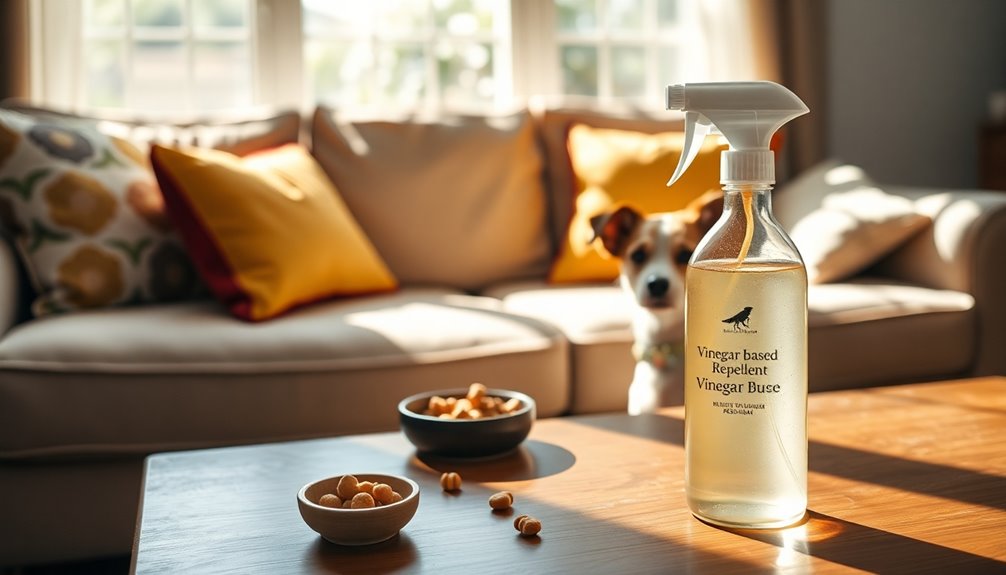
Vinegar-based repellents can be a simple yet effective solution for keeping your dog off furniture. To create your own, mix 1 part vinegar with 5 parts water. It's best to use clear vinegar, like white or apple cider vinegar, to prevent any discoloration on your furniture. Before applying the solution, test it on a small, hidden area to ensure it won't damage the material. Use a new spray bottle to avoid mixing scents from previous contents.
Spray the vinegar solution generously on and around the furniture you want to protect. Make sure to cover every surface, and reapply frequently to maintain a strong odor that will deter your dog. Keep in mind that vinegar's sour smell is unpleasant for dogs, making it an excellent natural repellent. Dogs' sensitivity to various smells can enhance the effectiveness of your homemade deterrent.
However, avoid spraying the solution directly on your dog, and be cautious of using it in areas where your dog might accidentally ingest it. Monitor your dog's reaction to the vinegar, and discontinue use if necessary. By being consistent and careful, vinegar-based repellents can help you keep your furniture pet-free without harsh chemicals.
Lemon and Citrus Solutions
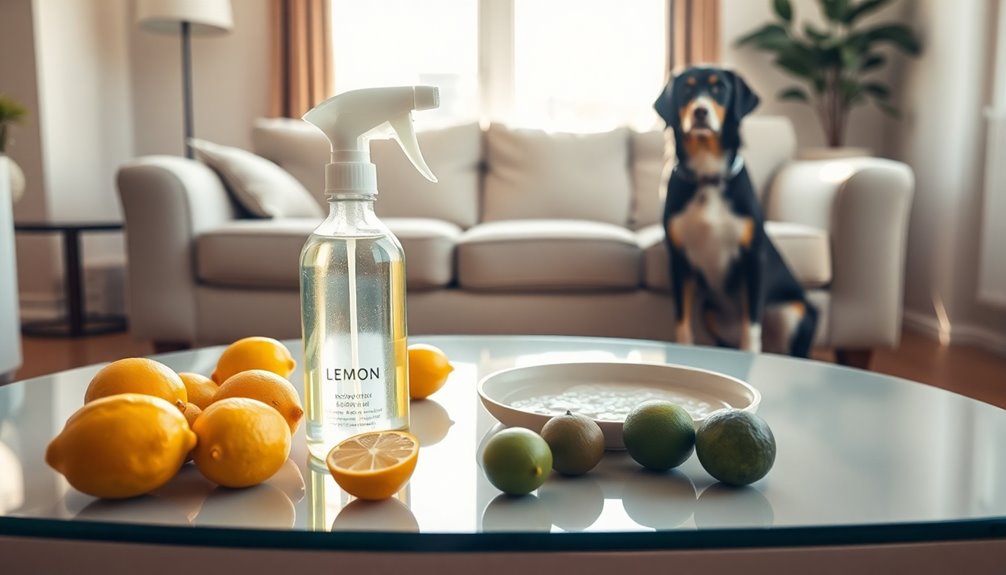
Harness the power of lemon and citrus solutions to keep your dog off furniture effectively. Dogs generally dislike strong citrus scents, making these natural remedies a great deterrent. To create your own citrus solution, mix one part lemon juice with three parts water for indoor use. For a stronger solution, add 2-3 drops of citrus oils to 8 oz of water.
Spray the mixture on the furniture or specific areas you want to protect. You can also test the solution on your hands and interact with your dog to gauge its effectiveness. Always test for staining on a small, hidden section of your furniture first. For outdoor use, apply lemon juice or place lemon peels in areas where you want to prevent digging or urination. Additionally, dogs intensely dislike citrus scents, making it an ideal choice for your remedy.
To ensure continued effectiveness, reapply your citrus solution regularly. You can enhance its impact by combining it with positive reinforcement training. Remember, citrus solutions are non-toxic and safe for your dog and the environment, making them a user-friendly alternative to harsher chemicals. By consistently using these methods, you'll help your dog learn to respect your furniture and keep your home smelling fresh.
Other Natural Deterrents

Finding effective natural deterrents can be key to keeping your dog off the furniture. One great option is a vinegar solution. Mix one part vinegar with five parts water, using apple cider or transparent vinegar to prevent any discoloration. You can also create a spray by combining two tablespoons of distilled white vinegar with 1 ½ cups of water. Always test the solution in an inconspicuous area first.
Another option is cayenne pepper. Mix a couple of spoonfuls with water in a spray bottle, keeping a ratio of about one part cayenne to ten parts water. Spray this mixture around the furniture; dogs are sensitive to the smell and taste, making it an effective deterrent. Dogs have heightened sense of smell and taste, making them particularly sensitive to cayenne pepper.
You might also consider ammonia, but use it cautiously due to its toxicity. Dip a cotton ball in an ammonia solution and lightly rub it on the furniture. Lastly, explore strong smells like eucalyptus or rosemary, which can deter dogs without causing discomfort.
Physical deterrents, like aluminum foil or pet training mats, can create an unwelcoming environment for your furry friend. Experiment with these options to find what works best for you.
Creating a Designated Space
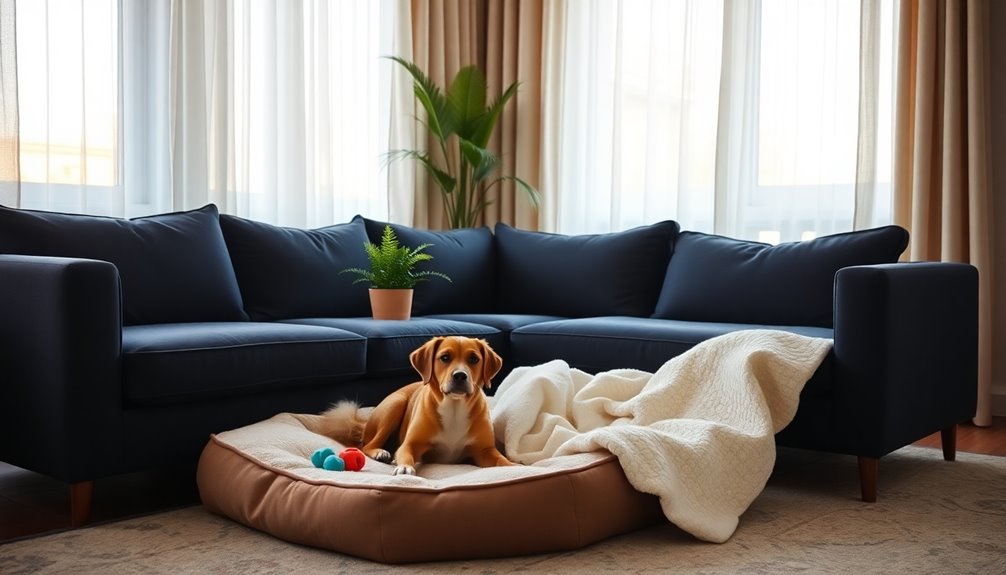
To effectively keep your dog off the furniture, creating a designated space just for them can make a significant difference. Identify the right spot in your home, such as a guest bedroom, laundry room, or even a nook under the stairs. If you prefer, you can designate a corner of an existing room, using dog gates or playpens to mark the area clearly.
Make this space comfortable by adding a cozy dog bed and some blankets. If you have the room, consider a pup-sized couch or human-style bed. Incorporate pet-friendly couch covers for shared spaces and install plush, grippy rugs to protect your dog's joints. Additionally, this designated space can help enhance their overall well-being by reducing anxiety and providing a safe environment. Providing interactive toys in the designated area can further stimulate their cognitive growth and promote emotional regulation.
Ensure the space is functional by opting for multifunctional furniture, like dog crate end tables, and hang hooks for leashes and gear. Don't forget to set up a feeding area with a food and water bowl station. Integrate this space into your home's design by using matching décor and furniture. With a little creativity, you can create a cozy and stylish designated space that keeps your dog off the furniture while making them feel right at home.
Maintaining Consistency and Patience
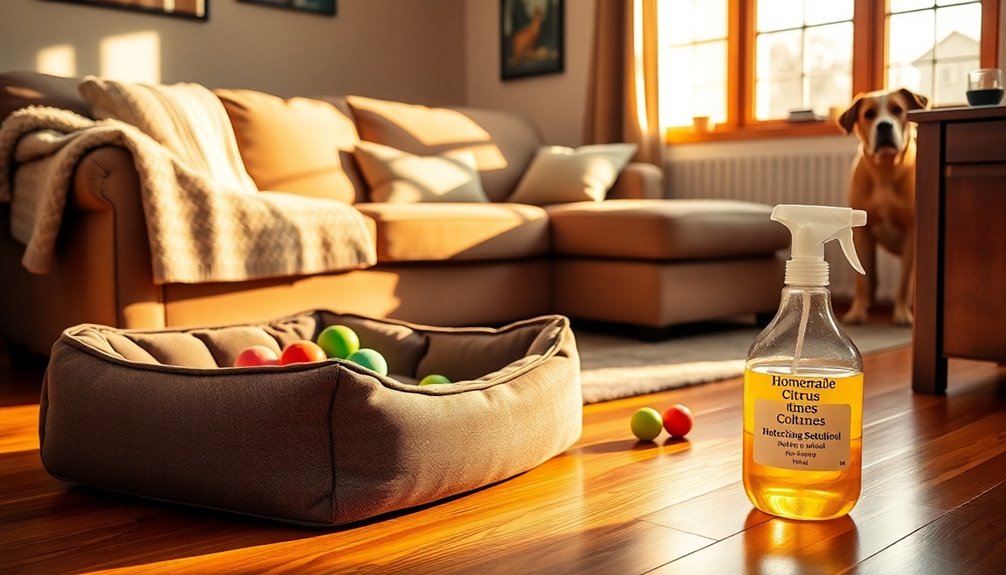
While training your dog to stay off the furniture, it's crucial to maintain consistency and patience throughout the process. Use the same command, like "Off," every time your dog jumps up to avoid confusion. Make sure everyone in your household agrees on the rules and commands to create a unified approach. Consistently enforce these rules, even if it's tempting to let your dog on the furniture occasionally.
Clear communication is key. Use firm commands and establish visual cues like baby gates to indicate off-limit areas. Remember, no exceptions should be made; this helps the dog grasp the boundaries. Training takes time, so be patient as your dog learns. Repeat training sessions to reinforce the "Off" command, and always use positive reinforcement—praise and treats work wonders. Additionally, consider using deterrents like spray repellents to further discourage your dog from accessing the furniture.
When your dog tests the boundaries, respond consistently. Redirect them to their designated space without overreacting. Avoid punitive measures, as they can lead to anxiety and confusion. Persist with your training, and stay committed. With consistent effort and patience, you'll find your dog gradually understands and respects the furniture rules.
Frequently Asked Questions
What Are the Best Dog Breeds for Apartment Living?
When you're considering the best dog breeds for apartment living, think about size, exercise needs, and temperament. Small breeds like Boston Terriers and French Bulldogs thrive in confined spaces. If you're looking for low-shedding options, Bichon Frises and Affenpinschers are great choices. For calm companions, Bulldogs and Cavalier King Charles Spaniels fit well. Always ensure they get enough exercise and mental stimulation, so they stay happy and healthy in your apartment!
How Long Does It Take to Train a Dog to Stay off Furniture?
Training a dog to stay off furniture can take several weeks, depending on the dog's age and temperament. You'll need to be consistent with your rules and practice daily. Older dogs might take a bit longer to adjust, while puppies may pick it up faster. Patience is key; your dog might test boundaries before fully understanding. With consistent reinforcement and clear commands, you'll see progress in no time!
Can Dogs Be Trained to Use Furniture With Supervision?
Yes, dogs can be trained to use furniture with supervision. You'll want to establish clear boundaries and guidelines for when they're allowed on the furniture. Use commands like "up" and "off" to reinforce the behavior you want. Always supervise their time on the furniture to ensure they understand the rules. Gradually, you can give them more freedom as they learn to respect the boundaries you've set. Consistency is key to successful training.
Are Any Furniture Materials More Resistant to Dog Damage?
When choosing furniture, consider materials that resist dog damage. Microfiber's tightly woven fibers repel scratches and pet hair, while leather offers durability and easy maintenance. Canvas and denim are tough, perfect for slipcovers, and solution-dyed acrylic fabrics can handle both indoor and outdoor wear. Each option provides a stylish look while standing up to your dog's claws and messes, ensuring your furniture stays in great shape despite your furry friend's antics.
How Do I Handle a Dog That Jumps on Furniture When I'm Not Home?
When your dog's jumping on furniture while you're away, start by blocking access. Use baby gates or place physical barriers to keep your dog off the furniture. Crate training can also help when you're not home. Reinforce the "off" command consistently, and reward good behavior with treats. Making the furniture less appealing, like using aluminum foil, can deter your dog, too. Stay consistent with these strategies, and you'll see improvement over time.
Conclusion
By using a combination of physical barriers, training techniques, and natural deterrents, you can successfully keep your dog off the furniture. Remember to create a designated space for them and be consistent with your approach. It takes patience, but with time, your furry friend will learn the boundaries you've set. Stick to your plan, and soon enough, both you and your dog will enjoy a comfortable home environment that respects everyone's space.
